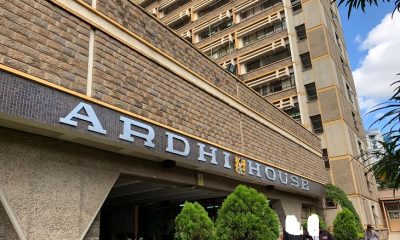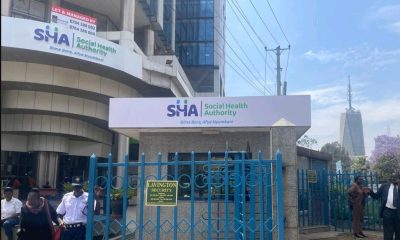News
Explainer: The Difference Between SHIF and NHIF

The transition from the National Health Insurance Fund (NHIF) to the Social Health Authority (SHA) will officially begin on October 1, 2024, as part of the government’s efforts to improve health coverage for all Kenyans.
President William Ruto introduced SHA as a replacement for NHIF, which has been in operation for over two decades.
Ruto stated that the new system aims to address gaps in NHIF and provide better services to all Kenyans, regardless of their economic status.
While , they also have distinct differences and similarities.
The Key differences between SHA and NHIF;
Legal framework
SHA is established under the Social Health Insurance Act of 2023, which repealed the NHIF Act of 1998. The new model introduces three distinct funds:
– The Primary Healthcare Fund (PHCF)
– The Social Health Insurance Fund (SHIF)
– The Emergency, Chronic, and Critical Illness Fund (ECCIF)
Access to healthcare
Under SHA, members can access primary health services and emergency treatment simply by registering as a member. Unlike the NHIF, there is no requirement to have up-to-date payments to access outpatient services.
NHIF’s coverage was more limited, especially for people with chronic conditions.
Outpatient services
SHA offers a wider range of outpatient services regardless of the patient’s premium payment status. While NHIF focused more on curative and rehabilitative care, SHA includes preventive, promotive, curative, rehabilitative, and palliative care.
Inpatient services
NHIF covered the cost of disease management during hospital admissions in wards, critical care units, or palliative care units.
Starting in October, SHA will standardise the daily treatment rate across hospitals based on their facility level, with an increased per-day rate of 12 percent.
Maternal care
Under NHIF, delivery costs for expectant mothers were covered as long as their membership was up-to-date.
On the other hand, SHA guarantees coverage for all deliveries and ensures every mother has insurance through full membership in SHIF. Expectant women unable to afford coverage will be identified at registration using a means-testing tool.
Linda Mama program
Previously, the Linda Mama program funded antenatal, delivery, and postnatal care services.
Government hospitals were reimbursed between Sh2,500 and Sh5,000 for normal deliveries, while private and faith-based facilities received between Sh3,500 and Sh17,000.
Under SHA, the normal delivery tariff will be Sh10,000, and Sh30,000 for C-section deliveries.
Renal Care services
NHIF covered hemodialysis for advanced kidney failure with a limit of two sessions per week.
SHA has expanded this to include three monthly Erythropoietin injections. The reimbursement for peritoneal dialysis has increased from Sh76,000 to Sh85,200, reducing out-of-pocket expenses by Sh9,200 per month.
The cost of renal replacement therapy (kidney transplant) has also risen, with surgery costs increasing from Sh450,000 to Sh700,000.
Mental health services
NHIF’s mental health coverage was limited to detoxification and rehabilitation for beneficiaries with substance abuse issues, reimbursed at Sh60,000 with a copay.
SHA on the other hand reduces the out-of-pocket payment for this package by Sh7,200. It also includes coverage for managing sickle cell disease, therapeutic aphaeresis, and the diagnosis and staging of cancer, which were not covered previously.
Surgical tariffs
SHA standardises surgical tariffs across all healthcare providers, whereas NHIF’s tariffs were limited to government and select private and faith-based facilities.
SHA will also contract foreign healthcare providers and negotiate treatment costs to enhance affordability, compared to the previous Sh500,000 overseas reimbursements.
New services
SHA also introduces new services not covered under NHIF, such as screening for common health conditions and cancers. It also covers the cost of consultation, preventive, and restorative treatments like extractions and scaling, as well as resuscitation and stabilisation for critical conditions.
Patients with permanent physical or sensory disabilities will be provided with necessary assistive devices.
SHA represents a major shift in Kenya’s health insurance model, with a focus on comprehensive coverage and accessibility.
The new system aims to provide better health services for all Kenyans, addressing the limitations of the NHIF and expanding the scope of care to include preventive and chronic illness management.
Kenya Insights allows guest blogging, if you want to be published on Kenya’s most authoritative and accurate blog, have an expose, news TIPS, story angles, human interest stories, drop us an email on [email protected] or via Telegram
-

 Investigations2 weeks ago
Investigations2 weeks agoNestlé Accused of Risking Babies’ Health in Africa with ‘Toxic’ Cerelac Product Sold Highest in Kenya
-

 Investigations1 week ago
Investigations1 week agoHow Land Grabbing Cartels Have Captured Ardhi House
-

 News2 weeks ago
News2 weeks ago48-Year-Old Woman Who Pushed 25-Year-Old Boyfriend To Death From 14th Floor Kilimani Apartment Arrested
-

 Investigations2 weeks ago
Investigations2 weeks agoKDC Rocked With Fresh Sh500 Million Tender Scam
-

 Grapevine2 weeks ago
Grapevine2 weeks agoMP Anthony Kibagendi Assault and Injures Kisii Man He Accuses Of Sleeping With One Of His Girlfriends
-

 Investigations5 days ago
Investigations5 days agoInside the Deadly CBD Chase That Left Two Suspects Down After Targeting Equity Bank Customer Amid Insider Leak Fears
-

 News3 days ago
News3 days agoSeven KDF Soldiers Accused Of Stealing Meth From Sh192 Million Mombasa Bust Detained For 10 More Days
-

 Business1 week ago
Business1 week agoPanic As Payless Africa Freezes With Billions of Customers Cash After Costly Jambopay Blunder






























